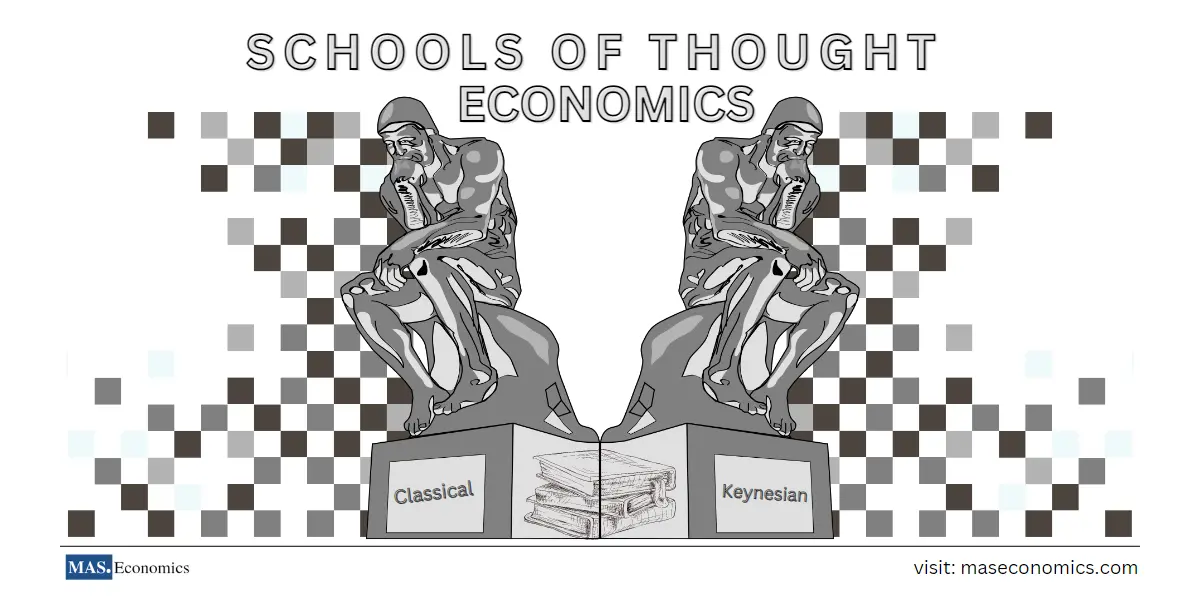Economics, often called the “dismal science,” has a surprisingly rich intellectual history. Over centuries, prominent thinkers have influenced diverse schools of economic thought. Each school offers a distinct analytical framework for examining economic phenomena, including market behavior, resource allocation, and the role of government intervention. Understanding these contrasting perspectives is essential for thoroughly grasping modern economic systems.
Let’s begin our exploration of different economic schools by first defining:
What are Schools of economic thought?
Schools of economic thought are distinct intellectual frameworks that economists utilize to analyze and interpret economic phenomena. These schools offer a shared language, core principles, and a specific methodological approach. This shared foundation allows economists to:
- Communicate Effectively: The common language and principles facilitate clear communication within the economic discipline.
- Develop Hypotheses: The frameworks guide the formulation of testable hypotheses about economic behavior and market dynamics.
- Evaluate Policy Options: Each school provides analytical tools for assessing potential consequences associated with policy decisions.
Now, before delving further, a summary table can offer useful context for discussing each school’s theories. Notable schools include:
| School of Thought | Focus and Key Principle |
|---|---|
| Mercantilism | Focus: Accumulation of wealth through trade, particularly gold and silver. Key Principle: Government intervention to achieve a favorable balance of trade. |
| Physiocracy | Focus: Agriculture as the primary source of wealth. Key Principle: Minimal government intervention, with a single tax on land rent. |
| Classical Economics | Focus: Free markets, self-interest, and division of labor. Key Principle: “Invisible hand” of the market leads to economic prosperity. |
| Neoclassical Economics | Focus: Rational behavior, utility maximization, price coordination. Key Principle: Marginal utility determines value; prices coordinate economic activity. |
| Austrian Economics | Focus: Individual decision-making, subjective valuations, and market processes. Key Principle: Subjective valuations and entrepreneurship drive economic change. |
| Chicago School of Economics | Focus: Rational choice and market efficiency. Key Principle: Limited government intervention, reliance on market mechanisms. |
| Keynesian Economics | Focus: Active government intervention to manage demand. Key Principle: Fiscal policy stabilizes the economy during downturns. |
| Monetarism | Focus: Controlling money supply to combat inflation. Key Principle: Tight monetary policy ensures economic stability. |
| Supply-Side Economics | Focus: Incentives, taxes, and deregulation for economic growth. Key Principle: Lower taxes and reduced regulations stimulate economic activity. |
| Public Choice Theory | Focus: Economic analysis of political decision-making. Key Principle: Individuals and groups act based on rational self-interest in politics. |
| New Keynesian Economics | Focus: Integrating microeconomic theory with Keynesian thought. Key Principle: Imperfect competition and wage/price stickiness influence economic outcomes. |
| Behavioral Economics | Focus: Integrating psychology into economic analysis. Key Principle: Human decision-making influenced by cognitive biases. |
| Institutional Economics | Focus: Role of institutions in shaping economic outcomes. Key Principle: Institutions create incentives and constraints affecting behavior. |
| Development Economics | Focus: Economic progress in less-developed countries. Key Principle: Structural transformations and targeted policies foster inclusive growth. |
| New Economic Thinking | Focus: Interdisciplinary approach to economics. Key Principle: Realistic assumptions, social justice, and innovation drive economic growth. |

|
|
Mercantilism
Mercantilism, the dominant economic doctrine in early modern Europe, emphasized the accumulation of gold and silver through international trade. Mercantilist policies aimed to maximize a nation’s exports while minimizing imports, leading to a favorable balance of trade. Governments intervened in the economy through tariffs, subsidies, and the establishment of colonies to secure raw materials and markets for finished goods.
While Mercantilism contributed to the rise of powerful nation-states and overseas exploration, it faced criticism for its zero-sum game approach, assuming that one nation’s gain was another’s loss. It also neglected the concept of comparative advantage and the benefits of free trade.
Physiocracy
Emerging in 18th-century France, Physiocracy challenged the mercantilist view by arguing that agriculture was the sole source of wealth. Physiocrats advocated for policies that would boost agricultural productivity, such as minimal government intervention and a single tax on land rent.
Although short-lived, Physiocracy introduced important concepts like the circular flow of income and laid the groundwork for later economic thought. However, it faced criticism for undervaluing the importance of manufacturing and trade in generating wealth.
Classical Economics

Classical economics, pioneered by Adam Smith, David Ricardo, and John Stuart Mill, marked a significant shift in economic thinking. This school emphasized the role of free markets, individual self-interest, and the division of labor in driving economic growth and prosperity.
Smith’s concept of the “invisible hand” suggested that individuals pursuing their own self-interest could unintentionally benefit society as a whole. Classical economists also introduced the labor theory of value and the concept of comparative advantage in international trade.
However, classical economics faced criticism for its assumptions of perfect competition and the self-regulating nature of markets, which didn’t always hold true in practice.
Neoclassical Economics

Neoclassical economics, which emerged in the late 19th century, introduced mathematical rigor and refined analytical tools to the field. This school emphasized the rational behavior of individuals and firms, utility maximization, and the crucial role of prices in coordinating economic activity.
The Marginal Revolution introduced the concept of marginal utility, challenging the classical view that value is determined solely by the cost of production. Neoclassical economists like Alfred Marshall, Leon Walras, and Vilfredo Pareto made significant contributions to the understanding of market dynamics and consumer behavior.
However, neoclassical economics has faced criticism for its oversimplification of human behavior, assumptions of perfect competition, and neglect of income inequality.
Austrian Economics

The Austrian school of economics emphasizes individual decision-making, subjective valuations, and the coordinating role of market processes. Pioneered by Carl Menger, Ludwig von Mises, and Friedrich Hayek, this school challenges the neoclassical focus on mathematical models and equilibrium analysis.
Austrian economists argue that demand and prices are driven by individuals’ subjective valuations rather than objective qualities. They highlight the importance of entrepreneurship and the market discovery process in driving economic change and progress.
According to Austrian thought, market competition and the interaction of buyers and sellers facilitate the efficient allocation of resources and coordination of economic activities. However, Austrian economics has been criticized for its subjectivism and skepticism toward mathematical modeling and empirical analysis.
Chicago School of Economics

The Chicago School of Economics, championed by economists like Milton Friedman and George Stigler, emphasizes rational choice and market efficiency. This school believes that individuals and firms make decisions based on rational considerations, aiming to optimize their satisfaction.
Chicago economists underscore the importance of the price system in coordinating economic activities and allocating resources efficiently. They advocate for limited government intervention and a reliance on market mechanisms to drive economic outcomes.
Influential figures like Milton Friedman and Eugene Fama significantly contributed to monetary theory, financial economics, and the efficient market hypothesis. While influential, the Chicago school has faced criticism for its assumptions about rational behavior and market efficiency.
Keynesian Economics

Keynesian economics, developed by John Maynard Keynes in response to the Great Depression, challenged the classical belief in the self-correcting nature of markets. Keynes argued that insufficient demand could lead to prolonged economic downturns and advocated for active government intervention through fiscal policy.
The concept of aggregate demand and the multiplier effect became central to Keynesian thought, emphasizing the role of government spending in stimulating economic activity. Keynesian policies influenced the development of modern welfare states and the use of fiscal stimulus during recessions.
Critics, however, raised concerns about government debt and potential inflationary pressures resulting from increased government spending.
Monetarism

Monetarism, championed by economists like Milton Friedman, emerged in response to the perceived limitations of Keynesian policies in addressing inflation. This school emphasized the importance of controlling the money supply to achieve economic stability and combat inflation.
Monetarists believed that excessive growth in the money supply leads to inflation, while a tight monetary policy can curb inflationary pressures. They generally favored limited government intervention and a rules-based approach to monetary policy.
However, monetarism faced challenges in predicting the velocity of money and has been criticized for its potential to slow economic growth under tight monetary conditions.
Supply-Side Economics

Supply-side economics, popularized by Arthur Laffer and Robert Mundell, emphasizes the role of incentives, taxes, and deregulation in driving economic growth. This school argues that lower taxes and reduced regulations can stimulate economic activity by increasing work, investment, and production incentives.
The Laffer Curve, a central concept in supply-side economics, suggests that at high tax rates, further increases may reduce overall tax revenue due to decreased economic activity. Supply-side economists believe altering incentives through policy changes can profoundly impact economic behavior and outcomes.
While influential in shaping economic policies, supply-side economics has been criticized by other schools, such as Keynesian economics, which argue for a more prominent role for government intervention and demand-side factors.
Public Choice Theory

Public choice theory applies economic analysis to political decision-making, bridging economics with political science and other social sciences. Pioneered by James Buchanan and Gordon Tullock, this field suggests that individuals and groups make political choices based on rational self-interest.
Public choice theory posits that political institutions, governments, and interest groups significantly influence economic policies and outcomes. Rational choice principles also apply to political decision-making, with individuals and groups acting to maximize their interests.
Buchanan’s “The Calculus of Consent” and Tullock’s work on rent-seeking are seminal contributions to this field. While providing valuable insights into the interplay between political and economic institutions, public choice theory has faced criticism for its assumptions about rational behavior in political contexts.
New Keynesian Economics

New Keynesian Economics emerged in the late 1970s as a response to the limitations of traditional Keynesian models in explaining stagflation. This school incorporated insights from microeconomic theory and rational expectations, addressing concepts like sticky wages and prices and imperfect competition.
New Keynesian economists such as Gregory Mankiw, David Romer, and Joseph Stiglitz provided explanations for price stickiness, such as menu costs and implicit agreements. Their models offered a more nuanced understanding of price and wage adjustments, bridging the gap between Keynesian and microeconomic theory.
However, New Keynesian models have faced criticism for their complexity and reliance on specific assumptions about rational expectations and market imperfections.
Behavioral Economics

Behavioral economics revolutionized economic analysis by integrating insights from psychology and cognitive science. Pioneering figures like Daniel Kahneman and Richard Thaler challenged the assumption of perfect rationality, demonstrating that individuals’ decision-making is often influenced by cognitive biases.
Behavioral economists introduced concepts like bounded rationality, loss aversion, and the importance of framing in shaping economic choices. Their work has had significant implications for understanding consumer behavior, investment strategies, and policy design.
Critics argue that the focus on biases in behavioral economics undermines the core principles of rationality in traditional models. Nonetheless, behavioral insights have become increasingly influential in both academic and policy circles.
Institutional Economics

Institutional economics highlights the importance of institutions, such as laws, norms, and organizations, in shaping economic outcomes. Scholars like Thorstein Veblen and Douglass North emphasized how institutions create incentives and constraints that influence individual and organizational behavior.
This school recognizes that economic activity is embedded within a broader social and historical context, and that power dynamics and the unequal distribution of resources can affect institutional formation and enforcement.
While institutional economics has enriched our understanding of the interplay between institutions and the economy, it has been criticized for lacking a unified theoretical framework and the challenges of measuring the precise impact of institutions on economic outcomes.
Development Economics

Development economics focuses on the economic transformation and progress of less-developed countries. Pioneering figures like Gunnar Myrdal and Amartya Sen established this field, recognizing the unique challenges faced by these nations in overcoming poverty and achieving sustainable growth.
Development economists emphasize the importance of structural transformations, human capital development, and targeted policies in critical areas like education, healthcare, and infrastructure. They acknowledge the role of institutions, good governance, and creating an environment that fosters entrepreneurship and investment.
While development economics has provided valuable insights into promoting inclusive growth, critics argue that some development models may be overly influenced by Western perspectives and fail to adequately account for local contexts and historical legacies.
New Economic Thinking

In the wake of the global financial crisis, New Economic Thinking emerged as a response to the limitations of traditional models. This approach calls for a more pluralistic and interdisciplinary understanding of economics, integrating insights from sociology, psychology, ecology, and other disciplines.
New Economic Thinking recognizes the limitations of models that rely on unrealistic assumptions of perfect rationality and market efficiency. It emphasizes the importance of considering distributional effects, social impacts, and the role of institutions in shaping economic outcomes.
Prominent figures like Dani Rodrik, and Mariana Mazzucato have contributed to this school, advocating for a broader approach to economics that considers social justice, innovation, and the role of the state in fostering growth.
While New Economic Thinking is still developing as a cohesive framework, its emphasis on interdisciplinarity and more realistic assumptions about human behavior is gaining traction among economists and policymakers.
Conclusion
The exploration of economic schools of thought serves as a cornerstone for comprehending the intricacies of modern economic systems. By delving into the contrasting perspectives offered by Mercantilism, New Economic Thinking, and the plethora of schools in between, economists gain a multifaceted understanding of market forces, resource allocation, and the potential for government intervention.
Thanks for reading! If you found this history of economic schools of thought helpful, share the knowledge with friends and spread it on social media!
Happy learning with MASEconomics



